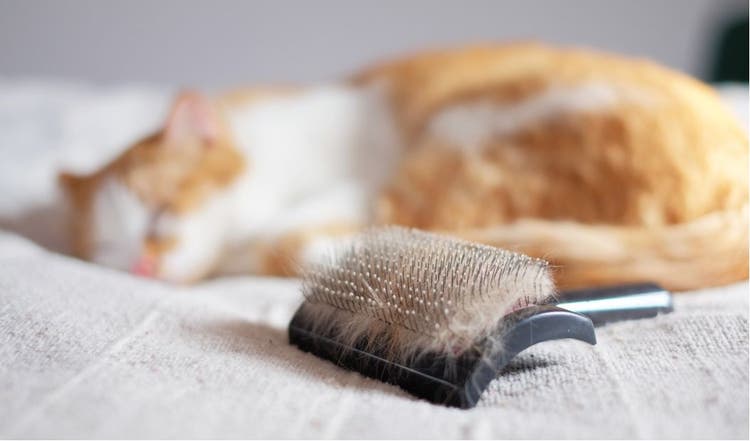
Looking Sharp: A Guide to Grooming Your Cat
Believe it or not, most cats need a little help with their grooming — and owners should pay attention to their cats’ eyes, ears, and coat.
Whether purebred or mixed breed, a key to good grooming lies in the length of a cat’s coat. A cat with a very short, single coat similar to the Siamese, Burmese, and Cornish rex needs very little grooming. The dense-coated shorthaired cats like American shorthairs, British shorthairs, and Scottish folds require a monthly grooming session. Semi-longhaired cats resembling Maine coons should be combed and bathed even more regularly. Cats with long, flowing coats resembling the Persian should be combed and have their faces cleaned at least every other day, and they should be bathed weekly or bi-weekly. Their ears should also be cleaned.
Keeping your cat healthy means paying regular attention to bathing, grooming, and brushing. Even cats with short hair will benefit from this often overlooked aspect of his health. Grooming does more than just make your cat look and smell nice. Here are the top medical reasons why regular grooming will help your cat stay healthy and feel better.
Tips for Grooming Your Cat
Keeping your pet’s face free of long hair that can irritate the eyes will make him feel more comfortable and prevent eye problems. Longhaired cats have hair that may hang in the eyes causing irritation and damage to the cornea. Check your pet to see if there are hairs lying on the eye. These should be trimmed by a groomer to keep your cat’s face clean and clear. NEVER use scissors or sharp implements around the eyes.
Some cats have a problem with drainage from the eyes, which may have several causes. Check with your veterinarian to help rule out any medical conditions that can be treated. If the drainage is persistent, make sure you keep it wiped away. Skin and fur that stays constantly moist can discolor and become infected.
It’s that time again — time to trim your kitty’s toenails. But while some cats don’t seem to mind when you’re trimming their nails, others just plain don’t like it. And they are not at all shy about letting you know how they feel — by squirming and scratching. Following these suggestions for a proper nail trim might help you give your cat a not-so-arduous manicure.
Start young. The earlier you start clipping your kitty’s claws, the better used to it she will be. Frequent trims when your cat is young will help diminish any fear. Have your veterinarian show you how to do it the first time.
Learn the anatomy. Within the center of each toenail is the blood and nerve supply for the nail called the quick. Most cats have light colored nails so you can see the quick, a pinkish area in the middle of the nail. Cutting into the quick will result in pain and bleeding.
Use the proper instruments. There are a variety of nail trimmers available at pet stores or your veterinarian’s office. Human nail trimmers generally do not work — unless your pet is a young kitten with soft clear nails.
You can keep your cat from having a “bad hair day” by regularly brushing and combing his hair. Cats have many types of coats, but all of them need to be brushed and combed.
Some shorthair cats, such as the Bengal or Russian Blue, have sleek hair that’s flat against their bodies. Shorthair cats, such as the Exotic or Manx, have thick hair with dense or cottony undercoats. Longhair cats, such as the Turkish Angora or Norwegian Forest cat, have soft, silky hair that is easy to brush and comb while others, such as the Persian, have coarse hair with an undercoat that knots up more frequently. Some cats, such as the Devon or Selkirk Rex, have curly hair. Even though you’ll never have to give a curly cat a perm or put his hair up in rollers, you’ll still have to brush and comb him regularly.
Brushing and combing will keep your cat from developing painful knots, often difficult to remove without the services of a professional groomer. If your cat must be shaved due to excessive knotting, a veterinarian must perform the procedure, and your cat will have to be anesthetized.
Grooming helps minimize the formation of hairballs — hair that a cat ingests as he washes himself. If a hairball lodges in your cat’s digestive tract, it may require surgery to remove.
Grooming Your Cat: To Shave or Not to Shave
Are summer shave downs good for cats? Do cats love it? Does shaving all the hair really keep a cat cooler?
As the temperatures rise across the country, many well-intentioned cat parents consider shaving cats to keep them more comfortable with the warmth and humidity. After all, we don’t want to wear a fur coat during the summer, so why should our cats?
Common sense tells us that shaving off a dense fur coat would help keep cats cooler in hot weather, but shaving your cats down actually robs them of their own natural defense against summer heat and sunburn.
Cat fur is entirely different from human hair. For both dogs and cats, their fur coats help them regulate their temperatures in both cold and warmer weather, similar to insulation for our houses.
Unlike human hair, cat fur has different layers that are responsible for your cat’s comfort and temperature control. If you do decide to trim down your cat’s coat during the next heat wave, keep these tips in mind.
Resources for Grooming Your Cat
Want more useful information about grooming your cat? Check out our featured articles: